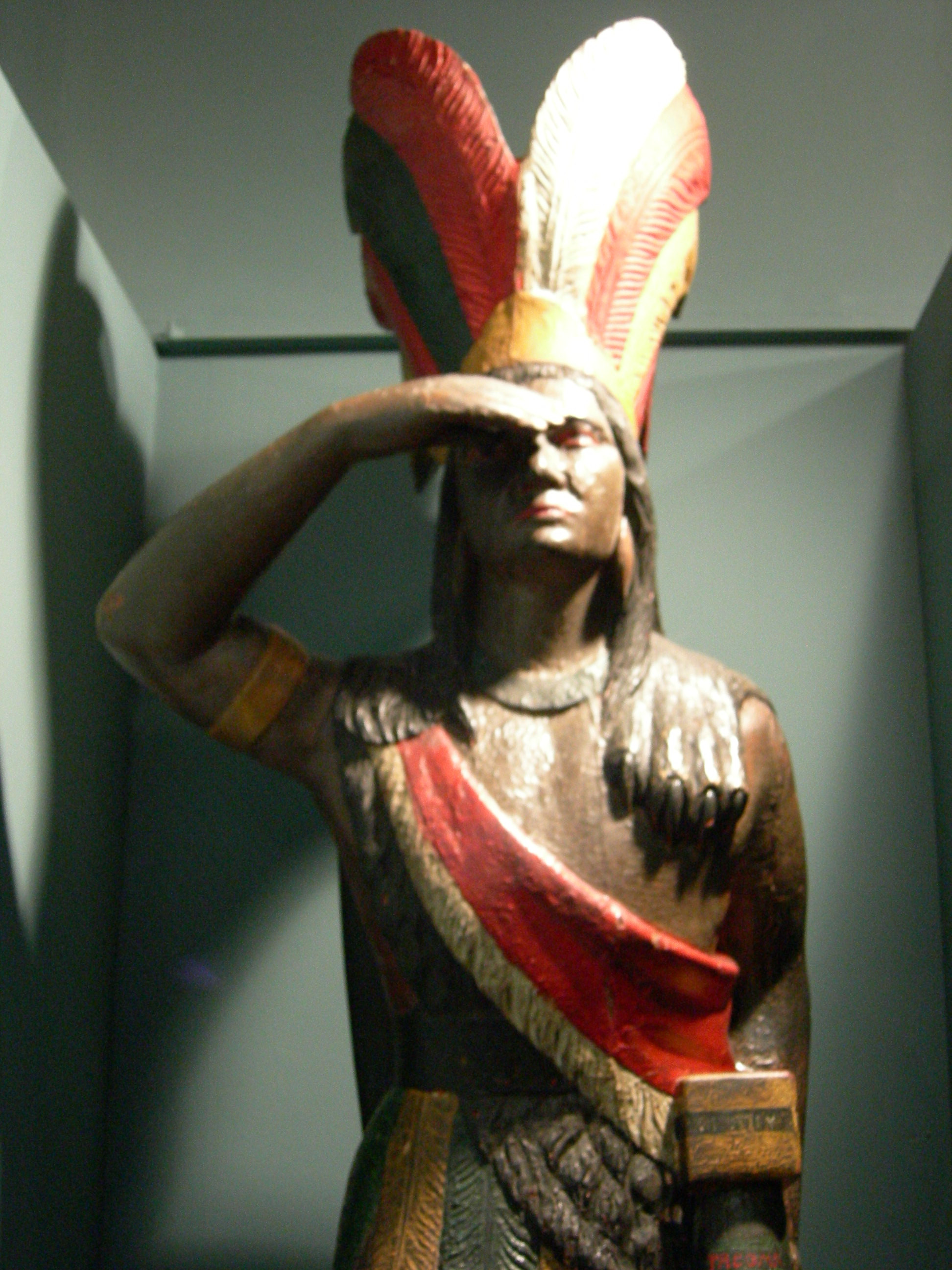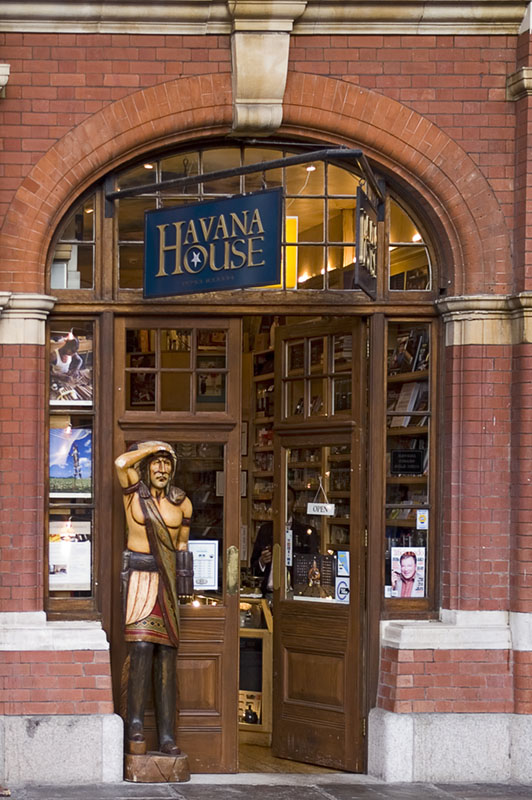Wooden Indian on:
[Wikipedia]
[Google]
[Amazon]

 The cigar store Indian or wooden Indian is an advertisement figure, in the likeness of a Native American, used to represent tobacconists. The figures are often three-dimensional wooden sculptures several feet tall – up to life-sized. They are still occasionally used for their original advertising purpose, but are more often seen as decorations or advertising collectibles, with some pieces selling for hundreds of thousands of dollars.
The cigar store Indian or wooden Indian is an advertisement figure, in the likeness of a Native American, used to represent tobacconists. The figures are often three-dimensional wooden sculptures several feet tall – up to life-sized. They are still occasionally used for their original advertising purpose, but are more often seen as decorations or advertising collectibles, with some pieces selling for hundreds of thousands of dollars.

 The cigar store Indian or wooden Indian is an advertisement figure, in the likeness of a Native American, used to represent tobacconists. The figures are often three-dimensional wooden sculptures several feet tall – up to life-sized. They are still occasionally used for their original advertising purpose, but are more often seen as decorations or advertising collectibles, with some pieces selling for hundreds of thousands of dollars.
The cigar store Indian or wooden Indian is an advertisement figure, in the likeness of a Native American, used to represent tobacconists. The figures are often three-dimensional wooden sculptures several feet tall – up to life-sized. They are still occasionally used for their original advertising purpose, but are more often seen as decorations or advertising collectibles, with some pieces selling for hundreds of thousands of dollars.
History
Because of the general illiteracy of the populace, early store owners used descriptive emblems or figures to advertise their shops' wares; for example,barber pole
A barber's pole is a type of sign used by barbers to signify the place or shop where they perform their craft. The trade sign is, by a tradition dating back to the Middle Ages, a staff or pole with a helix of colored stripes (often red and wh ...
s advertise barber shops, show globes advertised apothecaries and the three gold balls represent pawn shops. American Indians and tobacco had always been associated because American Indians introduced tobacco to Europeans. As early as the 17th century, European tobacconists used figures of American Indians to advertise their shops.
In 1667, King Charles II passed a law which forbade the use of overhead projecting signs because of the danger presented to passing traffic. A Highlander
Highlander may refer to:
Regional cultures
* Gorals (lit. ''Highlanders''), a culture in southern Poland and northern Slovakia
* Hill people, who live in hills and mountains
* Merina people, an ethnic group from the central plateau of Madagascar
...
figure indicated the sale of Scottish snuff, and a Blackamoor figure that tobacco from the Caribbean was available.
Because European carvers had never seen a Native American, these early cigar-store "Indians" looked more like Africans with feathered headdresses and other fanciful, exotic features. These carvings were called "Black Boys" or "Virginians" in the trade. Eventually, the European cigar-store figure began to take on a more "authentic" yet highly stylized native visage, and by the time the smoke-shop figure arrived in the Americas in the late 18th century, it had become thoroughly "Indian."
According to an 1890 article in the ''New York Times'':"Lo, the Wooden Indian", ''New York Times'', Aug. 3, 1890, page 13.
:It appears that the first man to introduce carved figures as tobacconists' signs was a certain Chichester. They were carved by one Tom Millard. This was about forty years ago. John Cromwell, Nick Collins, Thomas V. Brooks, and Thomas White are also prominent figures in the early history of the art.... Most of the men in the business originally carved figureheads for ships. But with the decay of American shipping they lost their occupation.... .A.Robb himself brought a good artistic training to the workshop, for he studied at the Academy of Design for a number of years.
The ''Times'' further notes that as the market became saturated with Indians, popular taste expanded to figures of Scotchmen, English officers with bearskins, Dolly Vardens, John L. Sullivan
John Lawrence Sullivan (October 15, 1858 – February 2, 1918), known simply as John L. among his admirers, and dubbed the "Boston Strong Boy" by the press, was an American boxer recognized as the first heavyweight champion of gloved boxing ...
, Edwin Forrest in Roman garb, Turks, sultanas, Punch, and plantation Blacks. The price of a small Indian was then $16, and full custom figures might cost $125. Most figures, however, were simply copied from existing ones.
The ''Times'' article describes traditional fabrication techniques as follows. The wood was typically white pine, bought as logs at spar yards. The artist first blocked out a very rough outline by axe, guided by paper patterns. A hole was then bored into each end of the log, about 5 inches in depth, and a bolt placed into each. The log was then suspended from these bolts on supports so it could freely turn. The sculptor then used chisels, followed by finer carving tools, to create the finished figure. Arms and hands were created separately, then screwed into the body. The last steps were to paint it, and set it up upon a stand.
Today
The cigar store Indian became less common in the 20th century for a variety of reasons. Sidewalk-obstruction laws dating as far back as 1911 were one cause. Later issues included higher manufacturing costs, restrictions on tobacco advertising, and increased sensitivity towards depictions of Native Americans, all of which relegated the figures to museums and antique shops. Many also were destroyed during scrap drives for metal and wood during World War I and World War II. Cigar store figures are now viewed as folk art, and some models have become collector's items, drawing prices up to $500,000. Modern replicas of cigar store Indians are still made for sale, some as cheap as $600. People within the Native American community often view such likenesses as offensive for several reasons. Some objections are because they are used to promote tobacco use as recreational instead of ceremonial. Other objections are that they perpetuate a "noble savage
A noble savage is a literary stock character who embodies the concept of the indigene, outsider, wild human, an "other" who has not been "corrupted" by civilization, and therefore symbolizes humanity's innate goodness. Besides appearing in man ...
" or "Indian princess
The Indian princess is usually a Stereotypes of indigenous peoples of Canada and the United States, stereotypical and inaccurate representation of a Native Americans in the United States, Native American or other Indigenous peoples of the America ...
" caricature
A caricature is a rendered image showing the features of its subject in a simplified or exaggerated way through sketching, pencil strokes, or other artistic drawings (compare to: cartoon). Caricatures can be either insulting or complimentary, a ...
or inauthentic stereotypes of Native people, implying that modern individuals "are still living in tepees, that we still wear war bonnets and beads." drawing parallels to the African-American lawn jockey.
Popular Media
Movies
*Human Highway
''Human Highway'' is a 1982 American comedy film starring and co-directed by Neil Young under his pseudonym Bernard Shakey. Dean Stockwell co-directed the film and acted along with Russ Tamblyn, Dennis Hopper, and the band Devo. Included is a c ...
features a cigar store Indian that the main character played by Neil Young talks to.
*Creepshow 2
''Creepshow 2'' is a 1987 American comedy horror anthology film directed by Michael Gornick, and the sequel to ''Creepshow''. Gornick was previously the cinematographer of the first film, and the screenplay was written by George A. Romero who was ...
's segment Old Chief Wood'nhead is based around revenge by an animated cigar store Indian.
TV
* The 1993 ''Seinfeld
''Seinfeld'' ( ) is an American television sitcom created by Larry David and Jerry Seinfeld. It aired on NBC from July 5, 1989, to May 14, 1998, over nine seasons and List of Seinfeld episodes, 180 episodes. It stars Seinfeld as Jerry Seinfeld ( ...
'' episode 'The Cigar Store Indian' features a cigar store Indian which Jerry
Jerry may refer to:
Animals
* Jerry (Grand National winner), racehorse, winner of the 1840 Grand National
* Jerry (St Leger winner), racehorse, winner of 1824 St Leger Stakes
Arts, entertainment, and media
* ''Jerry'' (film), a 2006 Indian fil ...
gives Elaine.
See also
* Blackamoor * Concrete Aboriginal *Jew with a coin
The Jew with a coin (, also little Jew (), or lucky Jew ()) is a good luck charm in Poland, where images or figurines of the character, usually accompanied by a proverb, are said to bring good fortune, particularly financially. For most Poles ...
* Lawn jockey
References
External links
*{{Commons category-inline, Cigar store Indians 17th-century introductions Stereotypes of Native American people Native Americans in popular culture Professional symbols Tobacco advertising Wooden sculptures